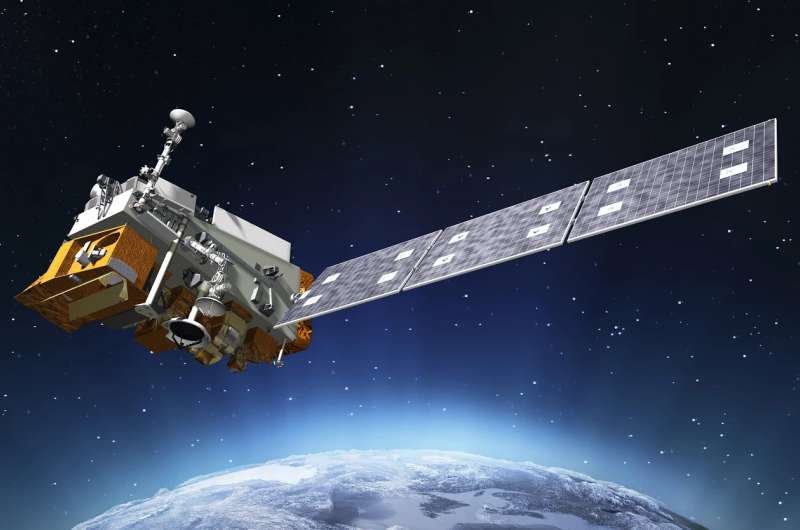Newly proposed reference datasets improve weather satellite data quality

"Traffic and weather, together on the hour!" blasts your local radio station, while your smartphone knows the weather halfway across the world. A network of satellites whizzing around Earth collecting mountains of data makes such constant and wide-ranging access to accurate weather forecasts possible. Just one satellite, such as the National Oceanic and Atmospheric Administration's (NOAA) Geostationary Operational Environmental Satellite-R that launched in 2016, can collect 3.5 terabytes of weather data per day.
But how do scientists ensure satellite-measured weather data is good? They can compare live data against high-quality reference data from in-orbit satellites. Making such resources available is a goal of the Global Space-based Inter-Calibration System (GSICS), an international consortium of 15 satellite agencies that collaborate on monitoring satellites and developing methods to ensure the quality of their weather data.
"The quality of the satellite data drives how prepared nations—and the world—can be when it comes to weather-related events," said GSICS Deputy Director Manik Bali, a faculty research assistant in the Earth System Science Interdisciplinary Center (ESSIC), a joint center of the University of Maryland and NASA's Goddard Space Flight Center. Bali is also a NOAA affiliate.
The World Meteorological Organization (WMO), a United Nations specialized agency and the Coordination Group for Meteorological Satellites (CGMS), launched GSICS in 2005. ESSIC contributes manpower and infrastructure support to GSICS, including the servers needed to share data between GSICS collaborators worldwide, enabling the monitoring of weather satellites among member agencies and the correction of measurement anomalies in real time.
One GSICS breakthrough came in 2011, with a paper demonstrating that a GSICS-developed algorithm corrected a temperature difference of approximately 3 degrees Celsius between two satellites. The results were published in the Bulletin of the American Meteorological Society. While that temperature difference may sound small, the world's nations recently negotiated the Paris Climate Agreement, which seeks to limit global warming to a maximum of 2 degrees Celsius above pre-industrial temperatures.
Also in 2011, Cheng-Zhi Zou, a NOAA research scientist and former chair of the GSICS Microwave Subgroup, intercalibrated 38 years of climate data—starting in 1979—to generate what NOAA calls a fundamental climate data record (FCDR). The FCDR was published in the Journal of Geophysical Research: Atmospheres.
At the American Geophysical Union's (AGU) fall meeting in December 2016, Bali demonstrated that Zou's FCDR was suitable for monitoring microwave satellites, including the Advanced Technology Microwave Sounder onboard NOAA/NASA's Joint Polar Satellite System (JPSS). When launched, JPSS will replace the aging National Polar-orbiting Operational Environmental Satellite System and provide full global monitoring coverage twice a day. Bali expects the FCDR will help monitor and adjust data gathered during JPSS missions.
At the recent AGU meeting, Bali also showed that the European Organisation for the Exploitation of Meteorological Satellites' Infrared Atmospheric Sounding Interferometer (IASI) and NASA's Atmospheric Infrared Sounder exhibit sufficiently stable behavior to serve as in-orbit references. Calibrating against these satellites can reduce errors from 2 degrees Celsius to below 0.1 degrees Celsius.
"This has given tremendous confidence to the GSICS calibration community that uses IASI-A as an in-orbit reference to monitor its geostationary satellites," said Bali.
Moving forward, Bali's colleagues at ESSIC will continue to support the science goals of the JPSS satellite mission through the Cooperative Institute for Climate and Satellites (CICS), which is managed by ESSIC and was created in 2009 through a $93 million agreement with NOAA.
"ESSIC's leadership in supporting these global initiatives is very important," said Bali. "Looking ahead, I see a far greater interaction between NOAA and ESSIC/CICS, which will help NOAA lead the global satellite calibration efforts."
The presentation, "Selection of on-orbit references for Global Space Based Inter-Calibration System" by Manik Bali, Fuzhong Weng, Lawrence E Flynn, Cheng-Zhi Zou, Ralph Ferraro and Thomas Pagano was given on December 13, 2016, at the American Geophysical Union Fall Meeting.
The paper, "The Global Space-Based Inter-Calibration System" by M. Goldberg, G. Ohring, J. Butler, C. Cao, R. Datla, D. R. Doelling, V. Gärtner, T. Hewison, B. Iacovazzi, D. Kim, T. Kurino, J. Lafeuille, P. Minnis, D. Renaut, J. Schmetz, D. Tobin, L. Wang, F. Weng, X. Wu, F. Yu, P. Zhang, and T. Zhu was published in the April 2001 issue of the Bulletin of the American Meterological Society.
The paper, "Intersatellite calibration of AMSU-A observations for weather and climate applications" by Cheng-Zhi Zou and Wenhui Wang was published on December 13, 2011 in the Journal of Geophysical Research: Atmospheres.
More information: M. Goldberg et al. The Global Space-Based Inter-Calibration System, Bulletin of the American Meteorological Society (2011). DOI: 10.1175/2010BAMS2967.1
Cheng-Zhi Zou et al. Intersatellite calibration of AMSU-A observations for weather and climate applications, Journal of Geophysical Research: Atmospheres (2011). DOI: 10.1029/2011JD016205
Journal information: Journal of Geophysical Research - Atmospheres , Bulletin of the American Meteorological Society
Provided by University of Maryland




















